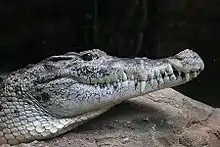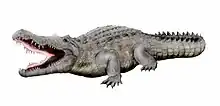| Crocodylus | |
|---|---|
 | |
| Mugger crocodile (C. palustris) | |
| Scientific classification | |
| Domain: | Eukaryota |
| Kingdom: | Animalia |
| Phylum: | Chordata |
| Class: | Reptilia |
| Clade: | Archosauromorpha |
| Clade: | Archosauriformes |
| Order: | Crocodilia |
| Family: | Crocodylidae |
| Subfamily: | Crocodylinae |
| Genus: | Crocodylus Laurenti, 1768 |
| Type species | |
| Crocodylus niloticus Laurenti, 1768 | |
| Species | |
|
See text | |
 | |
| Worldwide distribution of Crocodylus | |
| Synonyms[1] | |
| |
Crocodylus is a genus of true crocodiles in the family Crocodylidae.
Taxonomy
The generic name, Crocodylus, was proposed by Josephus Nicolaus Laurenti in 1768.[2] Crocodylus contains 13–14 extant (living) species and 5 extinct species. There are additional extinct species attributed to the genus Crocodylus that studies have shown no longer belong, although they have not yet been reassigned to new genera.[3]
Extant species
The 13–14 living species are:
| Image | Scientific name | Taxon authority | Common name | Distribution |
|---|---|---|---|---|
%252C_NPSPhoto_(9255693421).jpg.webp) | Crocodylus acutus | (Cuvier, 1807) | American crocodile | Southern Florida and the Atlantic and Pacific coasts of north Mexico to North America as far south as Peru and Venezuela, Cuba, Jamaica, Hispaniola and Grand Cayman. |
| Crocodylus halli [4] | Murray, Russo, Zorrilla & McMahan, 2019 | Hall's crocodile | southern New Guinea | |
 | Crocodylus intermedius | (Graves, 1819) | Orinoco crocodile | Colombia and Venezuela |
 | Crocodylus johnstoni | Krefft, 1873 | Freshwater crocodile | Northern regions of Australia |
 | Crocodylus mindorensis | Schmidt, 1935 | Philippine crocodile | Northern Sierra Madre Natural Park within the Luzon rainforest, San Mariano, Isabela, Dalupiri island in the Babuyan Islands, Abra (province) in Luzon and the Ligawasan Marsh, Lake Sebu in South Cotabato, Pulangi River in Bukidnon, and possibly in the Agusan Marsh Wildlife Sanctuary in Mindanao |
 | Crocodylus moreletii | (A.H.A. Duméril & Bibron, 1851) | Morelet's crocodile or Mexican crocodile | Mexico, Belize and Guatemala |
 | Crocodylus niloticus | Laurenti, 1768 | Nile crocodile or African crocodile, (the subspecies found in Madagascar, C. n. madagascariensis, is sometimes called the black crocodile) | Israel and Syria (historically), Somalia, Ethiopia, Uganda, Kenya, Egypt, the Central African Republic, the Democratic Republic of the Congo, Equatorial Guinea, Tanzania, Rwanda, Burundi, Zambia, Zimbabwe, Gabon, Angola, South Africa, Malawi, Mozambique, Sudan, South Sudan, Botswana, and Cameroon |
 | Crocodylus novaeguineae | Schmidt, 1928 | New Guinea crocodile | northern New Guinea |
_from_Ranganathittu_Bird_Sanctuary_JEG4362.JPG.webp) | Crocodylus palustris | (Lesson, 1831) | Mugger crocodile, marsh crocodile, or Indian crocodile | southern Iran, southern Pakistan, southern Nepal, India, Sri Lanka |
 | Crocodylus porosus | Schneider, 1801 | Saltwater crocodile or estuarine crocodile | Eastern India, Sri Lanka, Southeast Asia and Northern Australia |
 | Crocodylus rhombifer | (Cuvier, 1807) | Cuban crocodile | Cuba |
.jpg.webp) | Crocodylus siamensis | Schneider, 1801 | Siamese crocodile | Indonesia (Borneo and possibly Java), Brunei, East Malaysia, Laos, Cambodia, Myanmar, Thailand and Vietnam. |
 | Crocodylus suchus | Geoffroy, 1807 | West African crocodile or desert crocodile | Mauritania, Benin, Liberia, Nigeria, Niger, Cameroon, Chad, Central African Republic, Equatorial Guinea, Senegal, Mali, Guinea, Gambia, Burkina Faso, Ghana, Gabon, Togo, Ivory Coast and Republic of Congo |
| Crocodylus raninus (Considered to be a synonym of Crocodylus porosus; its status remains unclear).[5] | S. Müller & Schlegel, 1844 | Borneo crocodile | Borneo | |
Fossils
Crocodylus also includes five extinct species:[3]
- † Crocodylus anthropophagus is an extinct crocodile from Plio-Pleistocene of Tanzania.
- † Crocodylus checchiai is an extinct crocodile from Late Miocene of Kenya.
- † Crocodylus falconensis is an extinct crocodile from Early Pliocene of Venezuela.
- † Crocodylus palaeindicus is an extinct crocodile the Miocene to the Pleistocene of southern Asia.
- † Crocodylus thorbjarnarsoni is an extinct crocodile from Plio-Pleistocene of Kenya.
Evolution
Crocodylus likely originated in Africa and radiated outwards towards Southeast Asia and the Americas,[6] although an Australia/Asia origin has also been considered.[7] Phylogenetic evidence supports Crocodylus diverging from its closest recent relative, the extinct Voay of Madagascar, around 25 million years ago, near the Oligocene/Miocene boundary.[6]
Phylogeny
A 2018 tip dating study by Lee & Yates simultaneously using morphological, molecular (DNA sequencing), and stratigraphic (fossil age) data established the inter-relationships within Crocodylidae.[8] In 2021, Hekkala et al. were able to use paleogenomics, extracting DNA from the extinct Voay, to better establish the relationships within Crocodylidae, including the subfamilies Crocodylinae and Osteolaeminae.[6]
The below cladogram shows the results of the latest study:
| Crocodylidae |
| ||||||||||||||||||||||||||||||||||||||||||||||||||||||||||||||||||||||||||||||||||||||||||||||||||||||||||||||||||||||||||||||||||||||||||||||||
| (crown group) |
References
- ↑ Crocodylus . Retrieved through: Interim Register of Marine and Nonmarine Genera on 17 April 2022.
- ↑ Laurenti, J.N. (1768). "XV. Crocodylus". Specimen medicum, exhibens synopsin reptilium emendatam cum experimentis circa venena et antidota reptilium austriacorum [Medical Treatise, Exhibiting an Emended Synopsis of Reptiles, with Experiments Concerning Venoms and Antidotes for Austrian Reptiles]. Vienna: Joan. Thom. Nob. de Trattnern. pp. 53–55.
- 1 2 Brochu, C.A.; Storrs, G.W. (2012). "A giant crocodile from the Plio-Pleistocene of Kenya, the phylogenetic relationships of Neogene African crocodylines, and the antiquity of Crocodylus in Africa". Journal of Vertebrate Paleontology. 32 (3): 587. doi:10.1080/02724634.2012.652324. S2CID 85103427.
- ↑ Murray, Christopher M.; Russo, Peter; Zorrilla, Alexander; McMahan, Caleb D. (2019). "Divergent Morphology among Populations of the New Guinea Crocodile, Crocodylus novaeguineae (Schmidt, 1928) Diagnosis of An Independent Lineage and Description of A New Species". Copeia. 107 (3): 517–523. doi:10.1643/CG-19-240.
- ↑ Species Crocodylus porosus at The Reptile Database www.reptile-database.org.
- 1 2 3 Hekkala, E.; Gatesy, J.; Narechania, A.; Meredith, R.; Russello, M.; Aardema, M. L.; Jensen, E.; Montanari, S.; Brochu, C.; Norell, M.; Amato, G. (2021-04-27). "Paleogenomics illuminates the evolutionary history of the extinct Holocene "horned" crocodile of Madagascar, Voay robustus ". Communications Biology. 4 (1): 505. doi:10.1038/s42003-021-02017-0. ISSN 2399-3642. PMC 8079395. PMID 33907305.
- ↑ Oaks, J.R. (2011). "A time-calibrated species tree of Crocodylia reveals a recent radiation of the true crocodiles". Evolution. 65 (11): 3285–3297. doi:10.1111/j.1558-5646.2011.01373.x. PMID 22023592. S2CID 7254442.
- ↑ Lee, Michael S. Y.; Yates, Adam M. (27 June 2018). "Tip-dating and homoplasy: reconciling the shallow molecular divergences of modern gharials with their long fossil". Proceedings of the Royal Society B. 285 (1881). doi:10.1098/rspb.2018.1071. PMC 6030529. PMID 30051855.


